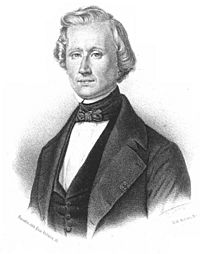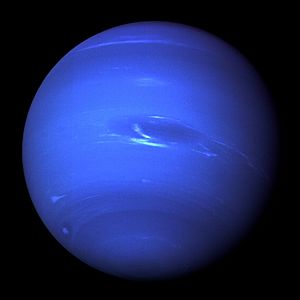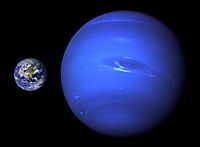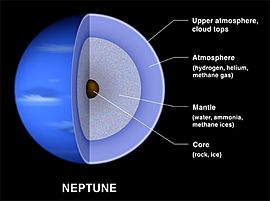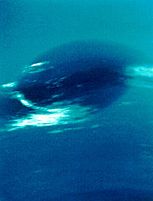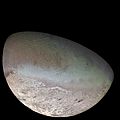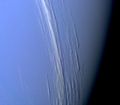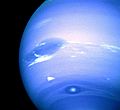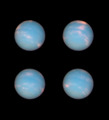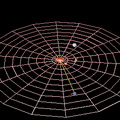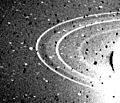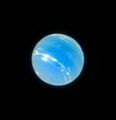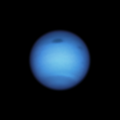Neptune facts for kids

Photograph of Neptune in true colour by Voyager 2 in 1989
|
|||||||||||||
| Discovery | |||||||||||||
|---|---|---|---|---|---|---|---|---|---|---|---|---|---|
| Discovered by | |||||||||||||
| Discovery date | 23 September 1846 | ||||||||||||
| Designations | |||||||||||||
|
Named after
|
Latin Neptunus, via French Neptune | ||||||||||||
| Adjectives | Neptunian, Poseidean | ||||||||||||
| Orbital characteristics | |||||||||||||
| Epoch J2000 | |||||||||||||
| Aphelion | 30.33 AU (4.54 billion km) | ||||||||||||
| Perihelion | 29.81 AU (4.46 billion km) | ||||||||||||
| 30.07 AU (4.50 billion km) | |||||||||||||
| Eccentricity | 0.008678 | ||||||||||||
|
|||||||||||||
| 367.49 days | |||||||||||||
|
Average orbital speed
|
5.43 km/s | ||||||||||||
| 259.883° | |||||||||||||
| Inclination | 1.770° to ecliptic 6.43° to Sun's equator 0.74° to invariable plane |
||||||||||||
| 131.783° | |||||||||||||
| 2042-Sep-04 | |||||||||||||
| 273.187° | |||||||||||||
| Known satellites | 14 | ||||||||||||
| Physical characteristics | |||||||||||||
|
Mean radius
|
24,622±19 km | ||||||||||||
|
Equatorial radius
|
24,764±15 km 3.883 Earths |
||||||||||||
|
Polar radius
|
24,341±30 km 3.829 Earths |
||||||||||||
| Flattening | 0.0171±0.0013 | ||||||||||||
| 7.6187×109 km2 14.98 Earths |
|||||||||||||
| Volume | 6.253×1013 km3 57.74 Earths |
||||||||||||
| Mass | 1.02413×1026 kg 17.147 Earths 5.15×10−5 Suns |
||||||||||||
|
Mean density
|
1.638 g/cm3 | ||||||||||||
| 11.15 m/s2 1.14 g |
|||||||||||||
|
Moment of inertia factor
|
0.23 (estimate) | ||||||||||||
| 23.5 km/s | |||||||||||||
| 0.67125 d 16 h 6 m 36 s |
|||||||||||||
|
Sidereal rotation period
|
0.6713 day 16 h 6 min 36 s |
||||||||||||
|
Equatorial rotation velocity
|
2.68 km/s (9,650 km/h) | ||||||||||||
| 28.32° (to orbit) | |||||||||||||
|
North pole right ascension
|
19h 57m 20s 299.3° |
||||||||||||
|
North pole declination
|
42.950° | ||||||||||||
| Albedo | 0.290 (bond) 0.442 (geom.) |
||||||||||||
|
|||||||||||||
| 7.67 to 8.00 | |||||||||||||
| −6.9 | |||||||||||||
| 2.2–2.4″ | |||||||||||||
| Atmosphere | |||||||||||||
| 19.7±0.6 km | |||||||||||||
| Composition by volume | |||||||||||||
Neptune is the eighth and farthest known planet from the Sun in our Solar System. It's a huge gas giant, similar to Jupiter and Saturn. Neptune is the fourth largest planet and the third heaviest. It is about 17 times heavier than Earth.
Neptune's atmosphere is mostly made of hydrogen and helium. It also has small amounts of methane. This methane makes the planet look blue. Neptune's blue color is much brighter than Uranus', even though Uranus has a similar amount of methane. Scientists are still trying to figure out why Neptune is so blue.
Neptune has the strongest winds of any planet in our solar system. These winds can blow as fast as 2,100 kilometers per hour (1,300 mph)! In 1989, a huge storm called the "Great Dark Spot" was found on Neptune. It was discovered by the Voyager 2 spacecraft. This storm was as big as the continent of Eurasia. However, by 1994, the Great Dark Spot had disappeared. New spots have been seen since then.
Neptune was discovered by Urbain Le Verrier and John Couch Adams. They were both honored for this important discovery. What makes Neptune's discovery special is that it was the first planet found using mathematical calculations. Astronomers noticed that Uranus was moving strangely in its orbit. This made them search for another large planet that might be pulling on Uranus.
The planet has only been visited by one spacecraft, Voyager 2. This visit happened on August 25, 1989. Scientists hope to send more space probes to Neptune in the future.
Contents
How Was Neptune Discovered?
Early Sightings and Calculations
The famous scientist Galileo might have seen Neptune first. His drawings show a star near Jupiter that was actually Neptune. But Galileo didn't get credit for discovering it. He thought it was just a "fixed star" because it moved so slowly. His small telescope wasn't powerful enough to show it as a planet.
In 1821, Alexis Bouvard published tables that predicted the orbit of Uranus. But later, astronomers saw that Uranus wasn't following its predicted path. It was moving in an irregular way. This made some astronomers think that another large object was pulling on Uranus.
In 1843, John Couch Adams calculated where this eighth planet might be. He sent his calculations to Sir George Airy, the Astronomer Royal. Airy asked Adams for more details, but Adams never sent his full reply.
The Official Discovery
In 1846, Urbain Le Verrier also made his own calculations. He wasn't working with Adams. Le Verrier also had trouble getting French astronomers to pay attention to his work. However, later that year, John Herschel supported the idea of finding a planet using math. He encouraged James Challis to search for the planet.
Meanwhile, Le Verrier convinced Johann Gottfried Galle to search for the planet. On September 23, 1846, Galle and his student Heinrich Louis d'Arrest found Neptune. They found it that very night! It was almost exactly where Le Verrier had predicted it would be. Challis later realized he had seen the planet twice in August but didn't recognize it.
After Neptune was discovered, there was a big argument between France and Britain. Both countries wanted credit for the discovery. Eventually, an international agreement decided that both Le Verrier and Adams deserved credit. However, some historians are now looking at old documents that were found in 1998. These documents suggest that Adams might not deserve as much credit as Le Verrier.
Naming the New Planet
Right after its discovery, Neptune was called "the planet outside Uranus" or "Le Verrier's planet." The first idea for a name came from Galle, who suggested Janus. In England, Challis suggested Oceanus. In France, Arago wanted to name it Leverrier, but many people outside France didn't like this idea.
Eventually, Adams suggested changing the name of Uranus from "Georgian" to "Uranus." Le Verrier then suggested "Neptune" for the new planet. Struve supported this name. Soon, "Neptune" was agreed upon by many people around the world. It became the official name for the new planet. In Roman mythology, Neptune was the god of the sea. He was like the Greek god, Poseidon.
What is Neptune Made Of?
Mass and Composition
Neptune is very massive, weighing about 17 times as much as Earth. But it's only about 1/18th the mass of Jupiter. Neptune and Uranus are often called "ice giants." This is because they are smaller than Jupiter and Saturn and have different materials inside.
Neptune's atmosphere is mostly hydrogen and helium. It also has a small amount of methane. This methane absorbs red light, which gives Neptune its blue color.
Neptune is very far from the Sun, so it gets very little heat from it. The top of its atmosphere is super cold, about -218 °C (55 K). But deeper inside the planet, the temperature slowly rises. Scientists don't fully understand where this internal heat comes from. It's strong enough to create the fastest winds in the Solar System!
Inside Neptune
The inside of Neptune is probably very similar to Uranus. It likely has a core made of molten rock and metal. This core is thought to be about 15 times the mass of Earth. Around the core is a mixture of rock, water, ammonia, and methane. The huge pressures inside Neptune keep this icy mixture solid, even though it's very hot near the core.
The atmosphere makes up about 10 to 20% of the planet's outer part. It's mostly hydrogen and helium high up. Lower down, there are more mixtures of methane, ammonia, and water. This hot, dark area slowly turns into a superheated liquid inside. The pressure at Neptune's center is millions of times greater than on Earth's surface.
Weather and Magnetic Field
Neptune has very active weather, unlike Uranus, which is much calmer. When the Voyager 2 spacecraft flew by Neptune in 1989, it saw powerful storms. Neptune's atmosphere has the fastest winds in the solar system. These winds are thought to be powered by heat from inside the planet. Winds near the equator can reach speeds of about 1,200 km/h (750 mph). Storm winds can go up to 2,100 km/h, which is almost supersonic!
In 1989, the Great Dark Spot was discovered. It was a huge storm system, like a tropical cyclone, as big as Eurasia. It looked similar to the Great Red Spot on Jupiter. However, when the Hubble Space Telescope looked at Neptune in 1994, the Great Dark Spot was gone. Instead, a new storm was found in the northern part of the planet. Scientists don't know why the Great Dark Spot disappeared.
Another storm, called the Scooter, is a white cloud group south of where the Great Dark Spot was. It got its name because it moved faster than the Great Dark Spot. The Wizard's eye was another strong storm seen in 1989.
Neptune's atmosphere has high clouds that cast shadows on lower clouds. Even though Neptune is very active, both Neptune and Uranus are made of similar gases and ices. They are both "ice giants," meaning they have a larger solid core and contain more ices than Jupiter and Saturn. Neptune is extremely cold, with temperatures as low as -224 °C (-372 °F) at the cloud tops.
Neptune's magnetic field is also interesting. It is strongly tilted compared to its rotational axis, by 47 degrees. It's also shifted away from the planet's center. Scientists think this unusual magnetic field might be caused by the way liquids move inside the planet.
Neptune's Rings
Neptune has very faint, blue-colored rings. They are not as famous or bright as the rings of Saturn. When these rings were first discovered, scientists thought they might not be complete rings. But Voyager 2 showed that they are full rings. Neptune's rings have a strange "clumpy" look. Scientists think this might be because of the gravity of small moons orbiting nearby.
The idea that the rings were incomplete came from observations in the 1980s. Stars would sometimes "blink" just before or after Neptune passed in front of them. Voyager 2 images in 1989 showed that Neptune has several faint rings. The farthest ring, called Adams, has three famous bright parts named Liberté, Egalité, and Fraternité (Liberty, Equality, and Fraternity).
It's hard to understand why these bright parts, or "arcs," exist. The laws of motion suggest they should spread out into a single ring very quickly. But the gravity of Galatea, a moon orbiting just inside the ring, is thought to keep these arcs together.
Voyager 2 also found other rings. Besides the thin Adams Ring, there's the Leverrier Ring and the wider, fainter Galle Ring. A small extension to the Leverrier Ring is called Lassell. The Arago Ring is outside the Lassell ring.
New observations from Earth in 2005 suggested that Neptune's rings might be more unstable than thought. It looks like the Liberté ring might disappear in less than 100 years. These new findings make understanding Neptune's rings even more puzzling.
Neptune's Moons
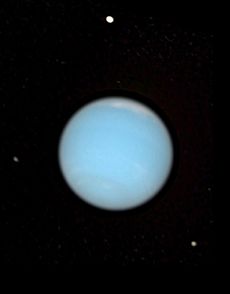
Neptune has 14 known moons. Triton is by far the largest moon. It makes up more than 99.5% of all the mass orbiting Neptune. Triton is the only moon large enough to be round. Triton was discovered by William Lassell just 17 days after Neptune itself was found.
Unlike most large moons in our Solar System, Triton orbits Neptune backward. This means it was probably captured by Neptune's gravity, rather than forming with the planet. It might have once been a dwarf planet in the Kuiper belt. Triton is slowly spiraling closer to Neptune. In about 3.6 billion years, it will get too close and be torn apart by Neptune's gravity. In 1989, Triton was the coldest object ever measured in the Solar System, with temperatures around -235 °C (38 K).
Neptune's second known moon, Nereid, has a very unusual orbit. It's one of the most stretched-out orbits of any moon in the Solar System. Its farthest point from Neptune is seven times its closest point.
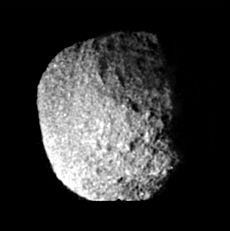
From July to September 1989, Voyager 2 discovered six more moons around Neptune. One of these, Proteus, is shaped irregularly. It's as large as a moon can be without its own gravity pulling it into a round shape. Neptune's four innermost moons—Naiad, Thalassa, Despina, and Galatea—orbit inside Neptune's rings.
Larissa was first seen in 1981 when it passed in front of a star. This event was first thought to be caused by ring arcs. But when Voyager 2 observed Neptune in 1989, it found that Larissa caused it. Five new irregular moons were found between 2002 and 2003. A new, very small moon, Neptune XIV, was found in 2013. Since Neptune was the Roman god of the sea, its moons are named after lesser sea gods.
How to Observe Neptune
Neptune is too faint to be seen with just your naked eye. Its brightness is usually between magnitudes +7.7 and +8.0. This means it can be outshined by Jupiter's Galilean moons and some asteroids.
You need a telescope or strong binoculars to see Neptune. It will look like a small blue dot, similar to Uranus. Its blue color comes from the methane in its atmosphere. Because it looks so small, it has been hard to study Neptune visually. Most of what we know comes from the Hubble Space Telescope and large telescopes on Earth with special technology.
Exploring Neptune
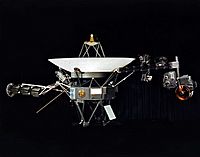
Voyager 2 is the only spacecraft that has ever visited Neptune. It made its closest approach to the planet on August 25, 1989. Since Neptune was the last major planet Voyager 2 could visit, scientists decided to make a very close flyby of its moon Triton. This was similar to how Voyager 1 explored Saturn and its moon Titan. The pictures sent back to Earth by Voyager 2 were amazing!
During the flyby, it took 246 minutes (over 4 hours) for signals from the spacecraft to reach Earth. So, Voyager 2 had to follow pre-programmed commands for most of its mission at Neptune. The spacecraft first flew close to the moon Nereid. Then, on August 25, it passed within 4,400 kilometers of Neptune's atmosphere. Later that same day, it flew close to Neptune's largest moon, Triton.
Voyager 2 confirmed that Neptune has a magnetic field. It also found that this field is tilted and offset from the planet's center, similar to Uranus. The spacecraft helped scientists figure out how fast Neptune rotates by measuring radio signals. Voyager 2 also showed that Neptune has a surprisingly active weather system. It discovered six new moons and confirmed that Neptune has more than one ring.
The flyby also gave scientists the most accurate measurement of Neptune's mass. It was found to be slightly less than previously thought. This new number helped disprove the idea that an undiscovered "Planet X" was affecting the orbits of Neptune and Uranus.
After the Voyager 2 mission, the next big step for exploring Neptune would be to send an orbiter mission. Such a mission might be possible in the late 2020s or early 2030s. There have been talks about sending missions sooner. In 2003, NASA considered a "Neptune Orbiter with Probes" mission. Another idea was for a spacecraft called Argo, which would fly by Jupiter, Saturn, Neptune, and a Kuiper belt object. This mission would focus on Neptune and Triton around 2029. The proposed New Horizons 2 mission (which was later canceled) might also have flown by Neptune.
Images for kids
-
The Great Dark Spot (top), Scooter (middle white cloud), and the Small Dark Spot (bottom), with contrast exaggerated.
-
In 2018, the European Southern Observatory developed unique laser-based methods to get clear and high-resolution images of Neptune from the surface of Earth.
See also
 In Spanish: Neptuno (planeta) para niños
In Spanish: Neptuno (planeta) para niños


